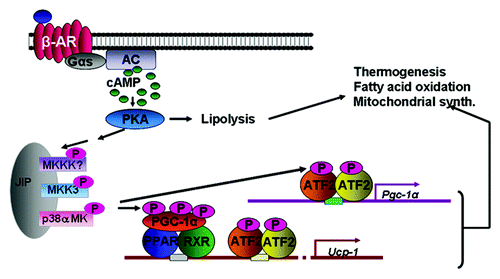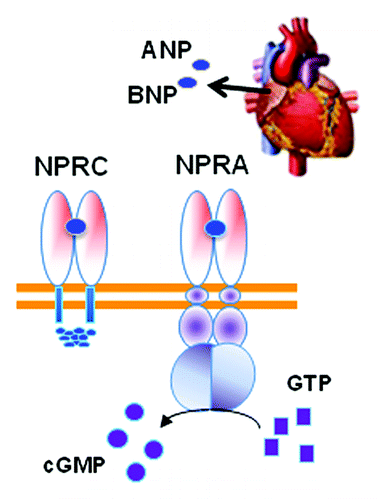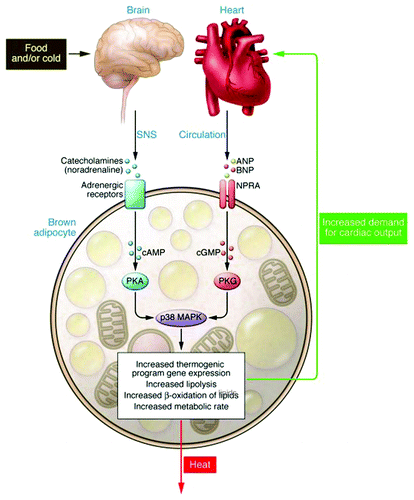Figures & data
Figure 1. Catecholamines bind the βARs on adipocytes to activate the Gs and increase cAMP. cAMP activates PKA, which can phosphorylate proteins to allow lipolysis of stored triglycerides. βARs and PKA can also activate a protein kinase cascade, culminating in the activation of p38α MAPK, which phosphorylates key transcription factors to promote transcription of the UCP1 and PGC-1α genes, mitochondrial biogenesis and thermogenic energy expenditure.

Figure 2. The cardiac hormones ANP and BNP released from the heart atria bind to the receptor NPRA to activate the intracellular guanylyl cyclase domain for the receptor to convert GTP to cGMP. Adipocytes also express NPRC that mainly removes NPs from circulation. The relative ratio of NPRA to NPRC is an important determinant of signal transduction.

Figure 3. Model for parallel βAR and NPRA activation of p38 MAPK to trigger expression of the brown fat thermogenic gene program. Catecholamines binding to βARs on adipocytes increases cAMP (pink ovals), which binds the regulatory (R) subunits of PKA. The released catalytic (C) subunits (purple ovals) phosphorylate targets including HSL and perilipin (Peri A), to allow lipolysis of stored triglycerides. Lipolysis can also be activated by NPs. ANP and BNP bind to guanylyl cyclase (GC) receptor NPRA to increase cGMP (yellow circles). The cGMP produced by NPRA activates PKG (thin green and yellow ovals), whose substrate specificity for phosphorylation closely overlaps that of PKA. Thus, PKG can phosphorylate the same targets as PKA to elicit lipolysis. βAR and NPRA signaling can also activate a protein kinase cascade culminating in the activation of p38α MAPK (p38 MK). Thus, in response to β-agonist or NPs, p38α MAPK phosphorylates (light blue ovals) the transcriptional regulators ATF2 and PGC-1α. PGC-1α interacts with PPARγ and RXRα. These phosphorylated and activated factors are recruited to specific motifs within the UCP1 enhancer (PPRE, CRE2) to increase its gene expression (blue arrow). ATF2 also binds the CRE in the PGC-1α promoter to increase transcription (blue arrow) and increase the amount of PGC-1α. Reprinted with permission from the Journal of Clinical Investigation.Citation52
